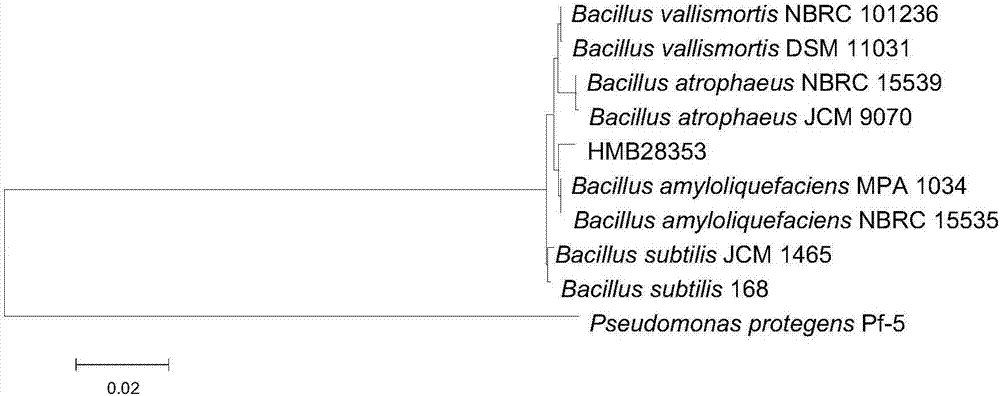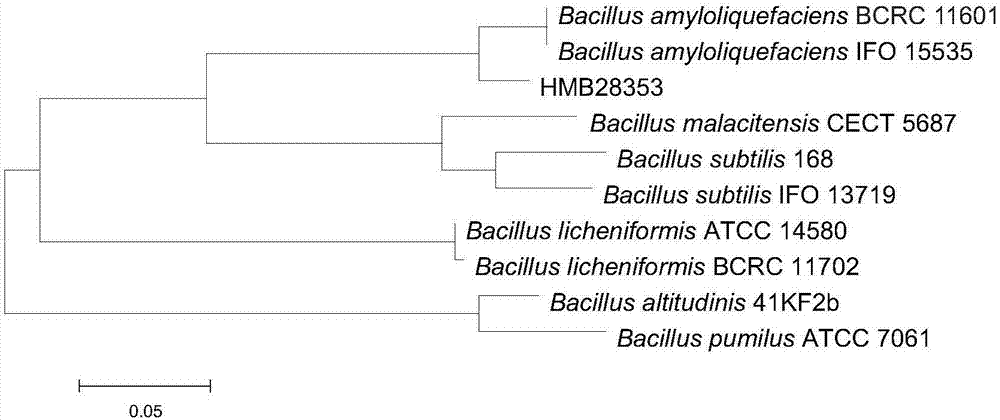Bacillus amyloliquefaciens HMB28353 and application thereof
A technology for dissolving starch spores and bacilli, applied in the application, bacteria, fungicides and other directions, can solve the problems of new or secondary diseases, pollution of agricultural products and environment, less understanding of resistant materials, etc. Highly targeted and durable
- Summary
- Abstract
- Description
- Claims
- Application Information
AI Technical Summary
Problems solved by technology
Method used
Image
Examples
Embodiment 1
[0049] The preparation of embodiment 1HMB28353 microbial bacterial agent
[0050] Follow the steps below:
[0051] (1) Strain activation: the Bacillus amyloliquefaciens strain HMB28353 stored at -80°C (this strain has been preserved in the General Microbiology Center of the China Committee for the Collection of Microbial Cultures on October 28, 2016, and the preservation number is CGMCCNo.13209 ) on LB plate medium (its composition and weight ratio are: tryptone 1g, yeast extract 0.5g, sodium chloride 1g, agar powder 15g, water 1000mL) to activate (30 ℃), pick a single colony In LB slant medium (its composition and weight ratio are: tryptone 1g, yeast extract 0.5g, sodium chloride 1g, agar powder 15g, water 1000mL) at 30 ℃ for 24 to 36 hours to obtain activated strains.
[0052] (2) Preparation of seed liquid: make LB liquid medium according to the conventional method (its composition and weight ratio are: tryptone 1g, yeast extract 0.5g, sodium chloride 1g, water 1000mL), i...
Embodiment 2
[0055] Embodiment 2 Antagonism test of HMB28353 bacterial strain of the present invention to cucumber target leaf spot bacterium
[0056] (1) Source of Cucumber target spot bacteria strain CA-1: Cucumber target spot bacteria CA-1 strain was collected from cucumber diseased leaves in Da Da Village, Mancheng County, Baoding City, Hebei Province, and was isolated and purified by the Institute of Plant Protection, Hebei Academy of Agriculture and Forestry Sciences. The Department of Plant Pathology, School of Plant Protection, Hebei Agricultural University identified it as Corynespora cassiicola, and the pathogenicity test showed strong pathogenicity.
[0057] (2) Test method:
[0058] Plate confrontation experiment: firstly, the CA-1 strain of target leaf spot of cucumber was activated and cultured on a PDA plate for 7 days, and then the Punch holes in the colony edge area to make bacterial flakes, transfer the cucumber target spot bacteria flakes to another PDA plate center, t...
Embodiment 3
[0063] Example 3 Comparison test of HMB28353 bacterial strain of the present invention on the control effect of cucumber target spot disease
[0064] (1) Test materials:
[0065] (1) Cucumber variety: Jinyou No. 1.
[0066] (2) Spore suspension of target leaf spot fungus CA-1 (the source of target spot fungus CA-1 is the same as in Example 2).
[0067] (2) Test treatment:
[0068] (1) HMB28353 liquid preparation: a 100-fold water dilution of the HMB28353 liquid preparation prepared in Example 1.
[0069] (2) Blank control: clear water.
[0070] (3) Test method:
[0071] (1) Cultivate cucumber plants: Cultivate Jinyou No. 1 cucumber seedlings in a nutrient bowl with a diameter of 6 cm. The seedling substrate is vermiculite. Two seeds are sown in each nutrient bowl, and one strong seedling is retained after emergence. When the cucumber seedlings grew two true leaves, they were transplanted into plastic flower pots with a diameter of 25 cm (the flower pots were filled with a...
PUM
| Property | Measurement | Unit |
|---|---|---|
| Diameter | aaaaa | aaaaa |
Abstract
Description
Claims
Application Information
 Login to View More
Login to View More - R&D
- Intellectual Property
- Life Sciences
- Materials
- Tech Scout
- Unparalleled Data Quality
- Higher Quality Content
- 60% Fewer Hallucinations
Browse by: Latest US Patents, China's latest patents, Technical Efficacy Thesaurus, Application Domain, Technology Topic, Popular Technical Reports.
© 2025 PatSnap. All rights reserved.Legal|Privacy policy|Modern Slavery Act Transparency Statement|Sitemap|About US| Contact US: help@patsnap.com



